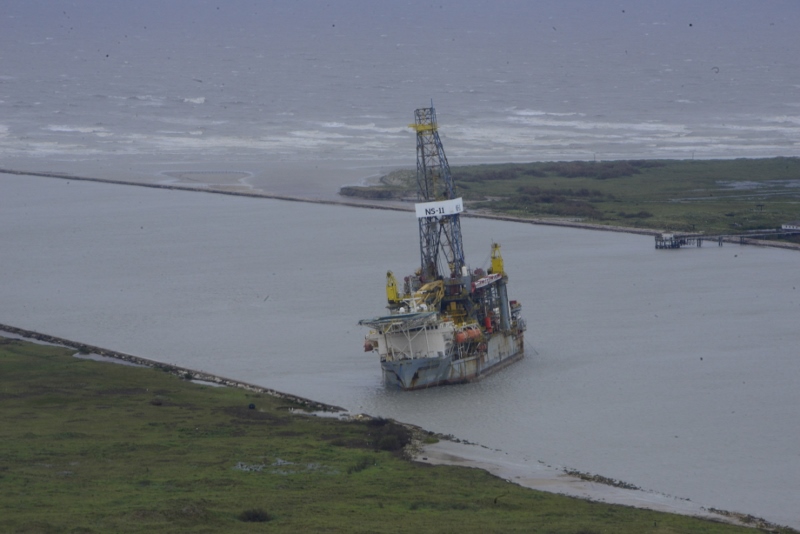As Tropical Storm Harvey beat onward toward Louisiana Tuesday, heavy rains continued to pummel Texas and energy hub ports remained closed to all shipping.
Every Texas port except Brownsville remained under Coast Guard condition Zulu Tuesday afternoon, with no vessel movements or activities save those authorized by the Coast Guard captain of the port. Shortly after 5 p.m. the condition was modified at Corpus Christi, to allow tugs and barges with drafts 20' or less to move within the inner harbor.
“The Coast Guard is working very closely with our federal, state and local partners to make sure we do this as safely and quickly as possible,” said Capt. Tony Hahn, incident commander and captain of the port in Corpus Christi, Texas. “We are continuing port assessments and collecting data on damage, debris and pollution in order to regain full operation of the affected ports. Port condition are a gradual, time-phased development based on impact of storm and assessment of safety conditions."
Offshore, 102 production platforms remained evacuated out of the 737 manned platforms operating in the Gulf of Mexico, the federal Bureau of Safety and Environmental Enforcement said in its daily update. Five out of 10 non-dynamically positioned drill rigs in the Gulf were still evacuated.
The production shut-ins represented an estimated 18.26% of Gulf oil production and 19.1% of natural gas, according to the BSEE.
Crude oil markets had little reaction to the storm’s impact. West Texas Intermediate crude prices, which were around $47.94 bbl. Sunday, dropped to $46.24 Tuesday afternoon, reflecting continuing oversupply of U.S. crude.
But gasoline prices were showing a sharp uptick in reaction to uncertainty awaiting damage assessments to the region’s refineries. Analyst Tom Kloza of the Oil Price Information Service said initial pops of 5 cents to 10 cents may add up to $2.50 gal. gasoline for the first time since late August 2015.
Eight refineries along the Gulf coast were shut down as of Tuesday afternoon, including Exxon Mobil's complex at Baytown, Texas, the second-largest in the U.S. The largest, the Motiva refinery at Port Arthur, Texas, was in operation, but Motiva said capacity was down to 60% due to problems with shipping and transportation.

Two crewmen on the tugboat Signet Enterprise await rescue by a Coast Guard helicopter crew at Port Aransas, Texas, during Hurricane Harvey Aug. 26, 2017. Coast Guard photo.
After the storm made first landfall on the Friday night, the Coast Guard rescued 15 persons from three workboats at Port Aransas, Texas. One was Signet Maritime’s 105’x34’, 4,400-hp tug Signet Enterprise, which was damaged and took on water while trying the secure the 449’x105’x26’ drillship Paragon DPDS1.
The operation involved two MH-65 helicopter crews in close collaboration and working with the crew of another tug, Signet’s 100’x40’x18’, 6,834-hp Signet Constellation. Another seven people were rescued aboard the vessel Sabine and airlifted to a rig near Aransas Pass, and four from Higman Barge Lines‘ 71’x37’ towboat Sandy Point.
The drillship, operated by Houston-based Paragon Offshore, grounded in the Aransas channel, posing one of many obstacles to reopening the Port of Corpus Christi, the nation’s fourth biggest in cargo handled. Refineries that shut down along the Houston Ship Channel awaited damage assessments, as the Coast Guard, authorities and civilian volunteers with boats rescued thousands from flooded neighborhoods.

A Coast Guard rescue swimmer, carrying an ax and chainsaw for urban rescues, walks to board a helicopter. Coast Guard photo.
As of midday Tuesday the Coast Guard reported it had rescued some 3,600 people, with 21 helicopters in operation and nine flood rescue punt boat teams in the region.
Meanwhile, the center of Harvey continued moving toward Louisiana and the National Hurricane Center raised tropical storm warnings as far east as Morgan City, La., and tropical storm watches to Grand Isle, La.





